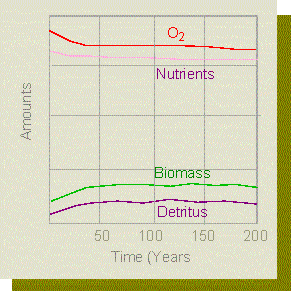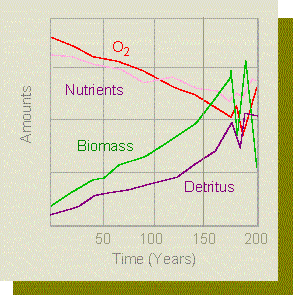
In the 70th and 80th of the 20th century, a number of projections were performed on the basis of measurements in order to predict future developments. These projections were done to help politicians in long-term planning. The 'Club of Rome', an organization of scientists with an interest in the challenges of the future, looked especially intensive into the global balance, the growth crisis of the human world population, and the effects of the destruction of the environment. Numerous simulations were performed in the groups of D. L. MEADOWS (Massachussetts Institute of Technology, USA) and E. PESTEL (Technological University of Hannover, Germany) during the 1970th. All calculations were based on the following two premises:
- The growth rates do not change
- all system variables depend on each other.
Different values were tested for one of the variables at a time in order to study the subsequently occurring changes of the other parameters of the system. In all models, it was assumed that the resources of the earth are limited and that the present exponential growth of both the human world population and the destruction of the environment makes changes necessary. Among the limited resources of the earth are:
- the supply of not renewable raw materials like mineral oil,
- the capacity of the environment to absorb harmful substances,
- the earth's stock of potential arable land,
- the yield per hectare arable land.
Nobody knows the limits exactly. Besides, they are difficult to characterize by a single number as they are reduced by the mismanagement of resources like the too high energy consumption of industrial nations or the destruction of natural resources in developing countries.
Feedback loops are of eminent importance in every construction of a model. They describe processes, in which the final product effects the starting product. Delaying factors have to be considered since many effects develop their full impact only after a delay, a fact that causes the excessive oscillations of some developments. Regulated systems are characterized by a negative feedback, because the final product inhibits its own synthesis. Positive feedback can lead to the escalation of a system that is thrown out of balance by it (see also growth factors). Before proceeding to examples, I will explain some technical terms and give some definitions (many of them are used in the chapter on eutrophication of water systems - for more details se also J. M. ANDERSON, 1973:
Oligotrophic lake (oligotrophic water system, oligotrophy): lake or water system that is poor in nutrients; lack of nutrients. Examples: mountain lakes and many Scandinavian lakes.
Eutrophic lake (eutrophic water system, eutrophy): lake or water system that is rich in nutrients. The Central European water systems, for example, belong into this category. Eutrophication is the process of increasing supply of nutrients that leads to a nutrient accumulation within the water systems. Among the most stressful nutrients are phosphates, nitrates and other inorganic substances as well as organic substances like non-purified sewage.
Detritus: amorphous dead organic substance that may float in sapropel or water
Epilimnion: upper, sunlight-rich and thus warmed layer of water in a stagnant water system
Hypolimnion: lower, dark and thus cold layer of water in a stagnant water system. A temperature drop layer, the metalimnion, develops between epilimnion and hypolimnion. The drop in temperature can be up to 10°C in a layer of less than 1 meter thickness.
In lakes of climates with seasons, the distinct separation between epilimnion and hypolimnion exists only in summer. During the winter months, the water intermixes and the drop in temperature is removed.
The model calculation is based on the assumption that lakes become eutrophic by a continuous supply of phosphate. The Bodensee, a large lake border by Germany, Austria, and Switzerland, that was oligotrophic well into the 20th century is a typical example. By now, eutrophication is at least locally well advanced. In 1960, the phosphate content was 20 mg/m3 while the production of plankton increased 20fold during the last 100 years. The reasons of the risen phosphate (and nitrate) supply were:
- The excess fertilization of agricultural areas with phosphate and nitrate, and
- phosphates as components of detergents that enter lakes and rivers by way of sewage. Only few sewage plants reduce the phosphate content even though it is technically possible.
The amount of organisms measured both as the amount of different species and the amount of individuals increases with increasing eutrophication, but the need for water-dissolved oxygen increases, too.
The following simplified causal chain is the result: the supply of nutrients causes an increased production of algae within the lake. At first, therefore, additional oxygen is set free. A large proportion of the newly produced oxygen enters the atmosphere, since photosynthetically active species occur mainly in the epilimnion and there only very close to the lake surface and since during summer, hardly any exchange between the different water layers occurs. Subsequent to the dying of the algae, the strongly oxygen-consuming process of bacterial degradation begins and as a consequence, the oxygen concentration of the lake decreases drastically. Species requiring a lot of oxygen die first and detritus accumulates as a layer of sapropel at the bottom of the lake. The rotting process consumes the remaining oxygen, while it produces toxic hydrocarbons like methan. This again leads to a further damage of the lake life. The final stage is the biological death of the lake. An extreme example of such a degenerative process is Lake Erie in the North of the USA.
Oligotrophic lakes are usually saturated in oxygen, while the oxygen content drops to 30 percent of the value of saturation in eutrophic lakes, especially in the hypolimnion. Eutrophication per se is not the same as the dying of all life within the lake. The majority of eutrophic lakes (among them almost all Central European lakes) is biologically well-balanced. Eutrophication is a phenomenon that occurs in almost every lake, even in those unimpaired by human influences. Natural eutrophication, nevertheless, takes thousands of years and is a first step in the succession:
oligotrophic lake > eutrophic lake > silting up > lowland bog > raised bog
Eutrophication caused by human influences, in contrast, takes only few decades; a period during which succession is completely impossible. Several measures against eutrophication can be taken:
A thorough processing of sewage with the aim to remove nutrients.
A distribution of sewage that covers a large area; discharge of sewage into fast-flowing rivers (but careful! The capacity of rivers and their ability to regenerate is larger than that of stagnant water systems, but they, too, do have a limited capacity).
The addition of algicides to the sewage.
Removal of sapropel from the bottom of the water system.
Harvesting of the algae (with the advantage that the dried algae can be used as dried fodder).
Addition of oxygen by ventilation.

Considering these preconditions, an oxygen and a nutrient cycle can be drawn up. Testing of the model requires quantitative details of the respective parameters. These values can be used. They are average values that have been collected in a variety of eutrophic lakes. They will be used as key figures in the following model calculation. The results are given as a flow chart that is the basis for a software.
The following results are obtained by the computer:

1. The course of a eutrophication under natural conditions. Precondition is a nutrient supply of 1 mg/l/year. The system is in equilibrium. The amount of biomass (and detritus) increases slightly, the amount of oxygen stays roughly the same. A nutrient supply of 10 mg/l/year changes the situation but little.

2. Increase in the supply of nutrients. This calculation begins with a nutrient supply of 10 mg/l/year and increases the value by 2 percent each year. That is sufficient for a final breakdown of the system - the biological death of the lake.
The use of algicides offers a first aid: the consequence is a lake that is saturated in oxygen and nutrients. At the same time, biomass and detritus take on the value 0. The result is a dead water system.

3. The second relief action: oxygen influx by artificial ventilation. In short-term, this measure leads to success, but the long-term effect is a further increase in biomass and detritus increasing the need of oxygen exponentially: a typical case of a positive feedback. The system does not enter equilibrium.
The consequence is that manipulations have, if any result at all, only short-term effects. The only measurement leading to a long-term success is a strong decrease in the nutrient supply.
|
|